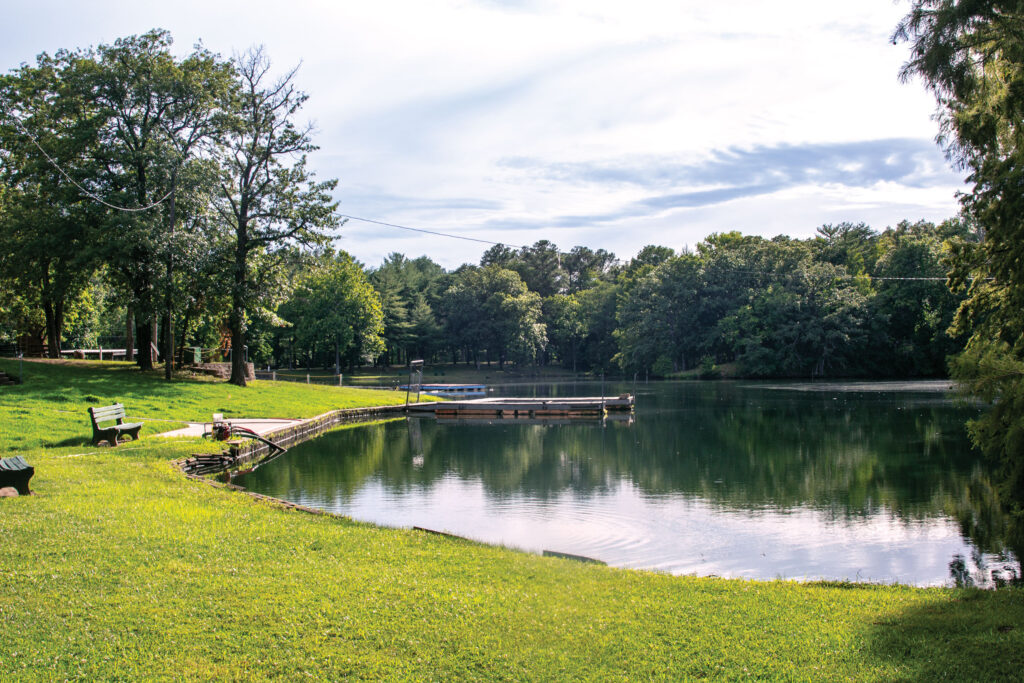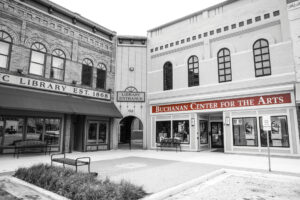Imagine taking a cross-country trip via Amtrak, and the most vivid memory of it being an ear of corn. That happened to New York Times Magazine columnist Caity Weaver in 2019. Of the experience, she wrote, “Shortly into its route, the [train] passes the single best thing in the United States: a silo in Mendota, Ill., with an 80-by-20-foot ear of corn painted on one side.”
Ray Paseka’s “Mendota Gold” — that giant ear of corn — has since been decommissioned, as the silo was deemed too unstable to hold the large-scale metal installation by an insurance company. Although it currently awaits a new home, other installations like it are popping up in small communities throughout the Illinois River Valley region.
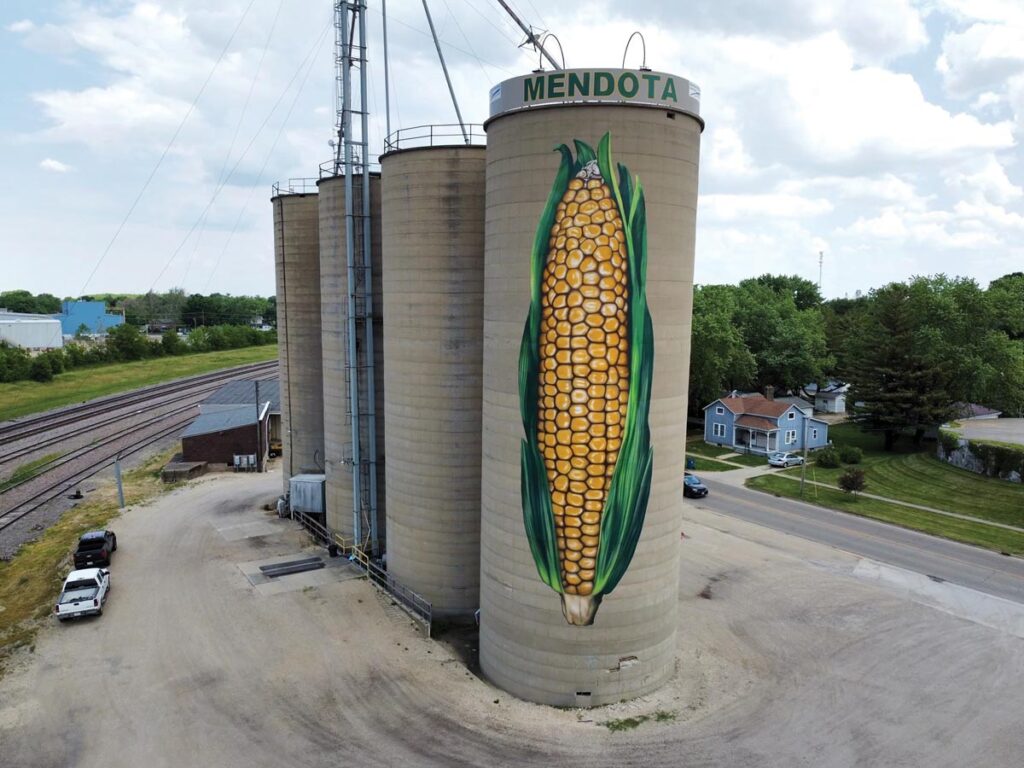
A countryside tour
That giant ear of corn was part of The Silo Pathways Countryside Public Art Tour, a curated outdoor art gallery in LaSalle, Bureau and Putnam counties, which has since broadened to include other types of public art.
“The project started as a concept in 2015,” says DeAnna Carlson of her brainchild. “The summer of 2016, we plotted 40 silos on the south side of the river and 40 silos on the north side of the river. It was designed [as a] regional rural tourism initiative.”
Additional help was needed to manage and fundraise for the project. “It was too big … for a little group of people,” says Carlson. “It really needed to go to a nonprofit for longevity.” Eventually, the tour was adopted as a legacy project by North Central Illinois (NCI) ARTworks in Peru.
“My role is to be the person who brings people from the east and west together,” says Julia Messina, executive director of the organization. “People have really good taste in a rural community … it’s a matter of getting them out to see what’s available. That’s my job: to get those people in here [the NCI ARTworks gallery] and to facilitate big projects like Silo Pathways.”
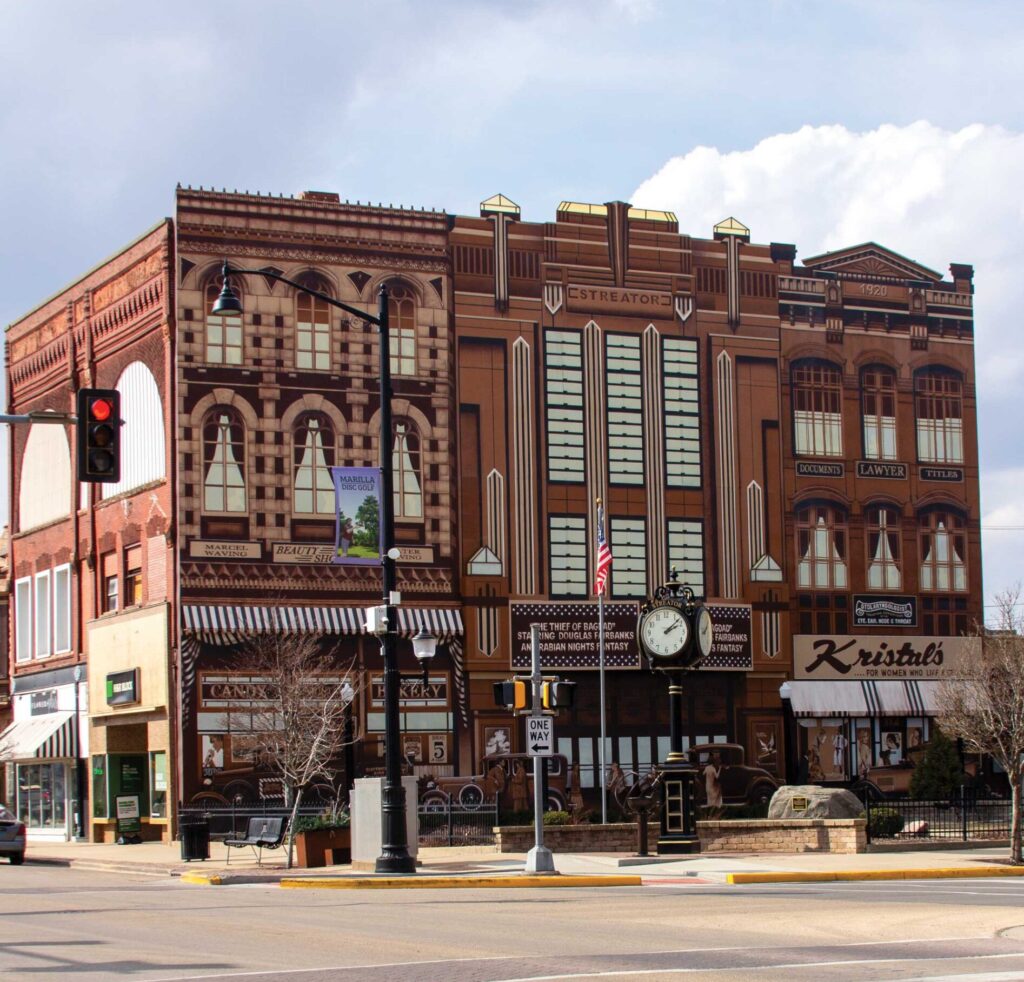
The project’s first installation, the “Heritage Park Vintage Wall” mural, was also created by Paseka and his team and completed in 2017 on the corner of Main and Monroe streets in Streator. In the years since, Carlson says the town has noticed its impact. “As of March 2023, 36 properties within two city blocks of Main and Monroe have been sold, purchased … or had facade grant renovations,” she says. “It’s lifted up the community.”
While the city of Streator purchased their mural, Carlson adds that there are different routes to bringing big art to a community, including work being commissioned by private citizens. “It’s the responsibility of the Silo Pathways committee to curate the art, what qualifies big art to be [a part of] this rural tourism initiative. … Then we work with [art] commissioners,” Carlson explains.
Chris Coughlin, the former head of NCI ARTworks, and her husband Jim were the longtime owners of CBW Insurance in Cherry and commissioned a piece by Paseka as a token of appreciation to their community for its many years of support. The resulting 12-by-22-foot mural, “Coal Power,” celebrates the town’s rich mining history.
The timeframe for these projects is typically at least a year, according to Carlson, allowing time for Paseka to research the area’s history and work with the commissioner on a concept. Once approved and curated, it enters fundraising mode.
“Once we get to 75-80% [of funding] … then the project starts,” says Carlson. “It’s really a lot of timing.” So far, five installations on the tour are complete — those in Streator and Cherry, as well as the Mary Uthoff Walkway Mosaic by Susan Burton in Princeton and Paseka’s “Union Station Depot” in Mendota and “Find Your Connection” mural in Seneca.
“We’re always looking for potential new projects. I have a handful of concepts that I’ve developed over the last couple of years that could be really striking,” says Paseka. “But we have to find the right situation to get them to fly.”

An artist and his work
“I did a lot of different things through the years,” says Paseka. “I used to do custom cars. I was in a band for a couple years, then started doing art installations in nightclubs and bars. That accelerated, and I met a guy, and we formed a company. We had every scenario you can imagine,” he laughs. He did that for almost 20 years in the Chicago area before moving back home to help his parents when both fell ill.
Later, he and a friend who did steel fabrication decided to open a shop. “He says, ‘Ray, let’s just go out to the boonies and find a cool space … and build a shop. You could do all kinds of interesting projects.’” They found a space in Mendota, but not long after, the friend died. It was the friend’s brother who urged Paseka to keep going.
About that time, he started networking with Carlson. “DeAnna is so motivated; she just wants to make things happen, and she introduced me to [Coughlin],” says Paseka. “I did a bunch of concepts … the challenge [was] trying to find abandoned silos … [and] getting some of the farmers to do it.”
Paseka also met Rick Brooks, former outreach program manager at the University of Wisconsin-Madison, co-founder of Free Little Libraries, and member of Midwest Partners, a civic engagement group. Brooks asked him if he could do a concept for a large-scale installation for a building in Princeton.
“He could not get the city to see the possibilities,” says Paseka. So, when that opportunity didn’t pan out, Brooks met with the city manager in Streator. Not long after, the “Heritage Park Vintage Wall” was underway. “It takes people who understand the potential of something. … These large pieces of art have an impression on people. … The whole area becomes energized.”
“He looked deeply into history, and identified some of the businesses and attractions, [and] depicted them,” says Brooks. “That was part of what inspired us to look at Illinois history and local history as a key part of the whole Silo Pathways idea.”
John Statkus, Paseka’s business partner, is an expert welder. “He builds grids that hold the panels we do the artwork on; everything we do is on aluminum sheets. That way we can take it in the studio, [in a] controlled environment,” says Paseka. They also use a special water-based clearcoat that preserves the paint for decades.
“John and his guys fabricate the steel grids, then the girls and I set the panels up at the shop,” he explains. “In Mendota, we [could] only do one row at a time. … We had to make sure each row corresponded to the one below and above. It was challenging; we had to work out a bunch of little systems to make sure everything coincided.” The logistics behind moving the panels themselves also proved daunting.
Despite the challenges, Paseka enjoys his work and the finished pieces for different reasons.
“We did the billboard in Cherry, which was a lot of fun, because we had to build a retro frame, and it looked like an old school billboard from back in the day with the warehouse lights over it,” he says. “We did a steam power billboard with the locomotive coming out of the mine, like a pro-America type of thing. Seneca was fun, because they’ve got a lot of history there,” he adds.
He has help with the creation and installation of each piece. In the early years of his career in Chicago, he worked with an all-female team of artists.
“When I came out to do this project, I thought to myself, ‘I’m going to do the same thing … I want young artists [who] want to be artists,” Paseka says. “I’ve got enough knowledge where I can teach them stuff … and give them something for their portfolios that would be impressive. When I was young, [there were] no opportunities; I had to make my own way. [So I said], ‘Look, here’s what I want to do. I’m going to interview a lot of young artists and put them on this project. They all get to work together, and we’re going to do something really, really powerful.’”
“What’s awesome about [Paseka] is that [he] isn’t just an artist. He is a mentor and a teacher, and over the course of his career, he’s always mentored other artists,” says Carlson. “He gives these young artists the opportunity to work and create these big works of art.”
A sense of place
Viewing a piece of art is a personal experience. However, its significance — particularly in the form of a public art installation — is far greater. It brings people to new places, bolsters small communities and instills a sense of pride in the people who live there. Those working behind the scenes to facilitate the process refer to it as asset-based community development.
“It’s focusing on the quality of life [in the community], not only the local economy, but also why people want to work and live here, how they can contribute and be a part and benefit from it,” says Brooks.
“Building community through art really helps. It helps with downtown and main street revitalization. We’ve seen that in Streator, and we’ll be tracking that in Mendota and Seneca with those projects,” Carlson adds. “It also gives our 2.2 million visitors who come to Starved Rock State Park an opportunity to go beyond the rock.”
“After I retired, I helped start the Small Business Development Center in Starved Rock,” says Brooks. “That’s how I first heard about [Paseka] and got to know people in Ottawa, LaSalle, Peru, Princeton … who were doing community development work in all those communities.
“The Starved Rock Country Alliance was a group of businesspeople who were trying to essentially kickstart some of the smaller communities in north central Illinois, and support local, independent businesses,” he adds. “All of us participating in it had a wider vision than just, ‘Can we get some large employers with hundreds of employees to come here?’ … We knew we had to focus on each community and what their assets and their needs were and build from there. … We needed to work on the quality of life in general.”
The asset-based community development model he’s describing is also known as placemaking. Carlson says Brooks gave her a lot of guidance on each step to presenting the Silo Pathways tour as a placemaking opportunity. “He really helped me think bigger,” says Carlson.
“My own philosophy about community development is, too often, we have focused on problems and negatives, and things that were missing, and we don’t focus enough on the assets and resources that have helped communities to survive,” Brooks says. “So, what we wanted to do is to use art and related activities as a way to say, ‘These are great places to live, great places to visit.’ … You add another step, and it’s not only to visit, but to come and live here. It’s got people thinking ‘It’s a good place to raise our children, to have a family.’
“Instead of a brick wall that’s deteriorating, [or] a building that’s falling down, there’s an image on the wall that depicts something that the city is proud of, and it inspires more,” he adds, citing the success of the Mary Uthoff Walkway Mosaic as an example. The project transformed an empty alley into a mosaic-clad sitting area with a sofa, chairs and table that has become a favorite spot for wedding and prom photos
in Princeton.
“Part of the whole Silo Pathways idea is that you can go from town to town and experience being there and knowing that there’s something special about that place,” he continues. “This part of Illinois has such rich resources, not only farm culture and land, but also the railroads and access to the rest of the United States through the interstate highway system, so we can be attractive not only for economic purposes, but also for tourism. … It takes people with imagination and creativity. It takes a champion locally.”
Brooks, an anthropologist, explains that once these types of community assets begin to be embraced, there’s a phenomenon that occurs called diffusion of innovation, where people adapt the idea in different forms and functions.
“Human beings are fascinating. We don’t want to just live in a box, in a house; we want to live … surrounded by things we created, that are part of us, part of what we remember, part of what we imagined, part of what we dream about,” Brooks explains. “[There’s a] similar emotional and psychological appeal that relates to public art. That is, you go to a place, and you see and experience something that someone valued and wanted to share.”
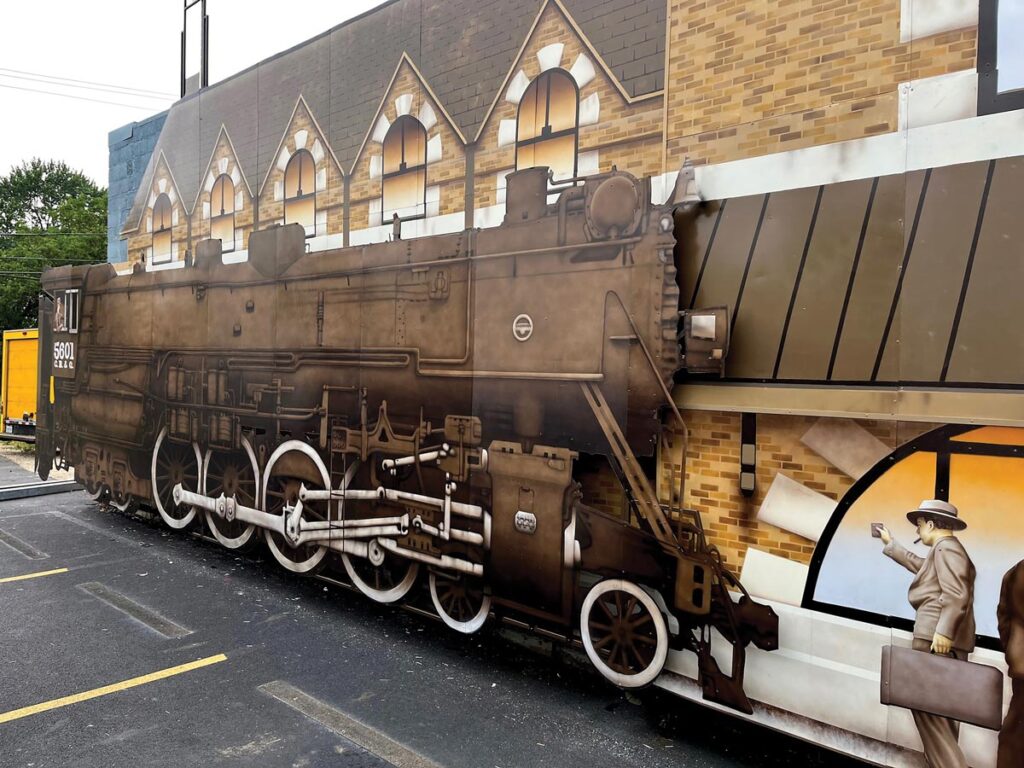
LET’S GO
The Silo Pathways Legacy Project is an ongoing public art gallery in the Illinois River Valley. While “Mendota Gold” (the 68-foot-tall ear of corn by Ray Paseka/Westclox Studios) has been decommissioned and is awaiting a new location, other stops remain along the tour.
- “Union Station Depot,” 801 Monroe St., Mendota (Ray Paseka/Westclox Studios) — a full-color, illuminated, 127-by-50-foot mural of the Union Train Depot built in 1888 at half-scale
- “Find Your Connection,” 311 N. Main St., Seneca (Ray Paseka/Westclox Studios) — an 80-by-32-foot mural commemorating Seneca’s historic contributions with the Landing Ship Tank manufactured at the Seneca Shipyard as its centerpiece
- “Coal Power,” 123 S. Main St., Cherry (Ray Paseka/Westclox Studios) — an installation depicting Cherry as the mining town that it was in the early 20th century, a 12-by-22-foot mural with vintage billboard design
- Prairie Dreams, South Main Street, Princeton (Susan Burton) — a mosaic-clad sitting area along The Mary Uthoff Memorial Walkway
- “Heritage Park Vintage Wall,” 222 E. Main St., Streator (Ray Paseka/Westclox Studios) — an 80-by-60-foot, internally illuminated installation
For more information, visit nciartworks.com and westcloxstudios.net.


